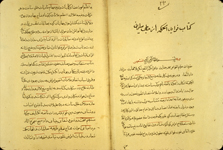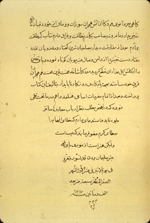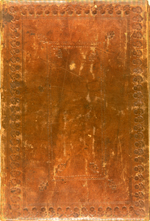Catalogue: Pharmaceutics
-
 Fawā’id al-ḥikmah
(MS P 8)
Fawā’id al-ḥikmah
(MS P 8) - (The Advantages of Wisdom)
- فوائد الحكمة
- by Sulaymān ibn Sulaymān ibn Muḥammad Karīm ibn Muḥammad Walī ibn Ḥājjī Himmat ibn ‘Īsá ibn Ḥasan (fl. before 1709/1121)
- حاجى سليمان ابن سليمان ابن محمد كريم ابن محمد ولى ابن حاجى همت ابن عيسى ابن حسن
This Persian treatise on simple and compound remedies is divided into two sections (matlabs). The first matlab contains an alphabetical discussion of medicaments, while the second is a list of synonyms for various medicaments.
Only one other copy is recorded, now in Cairo, copied in 1709/1121 (see Storey PL II,2, p. 316 no. 47).
Fawā’id al-ḥikmah (MS P 8)
Illustrations
The opening of a Persian treatise on simple and compound remedies titled Fawā’id al-ḥikmah, composed in the late 18th century by Sulaymān ibn Sulaymān ibn Muḥammad Karīm ibn Muḥammad Walī ibn Ḥājjī Himmat ibn ‘Īsá ibn Ḥasan, about whom very little is known. The copy was made in 1802 (1217 H).
The beginning of the second section (matlab), concerned with synonyms for various medicaments, from a Persian treatise on simple and compound remedies titled Fawā’id al-ḥikmah. It was composed in the late 18th century by Sulaymān ibn Sulaymān ibn Muḥammad Karīm ibn Muḥammad Walī ibn Ḥājjī Himmat ibn ‘Īsá ibn Ḥasan, about whom very little is known. The copy was made in 1802 (1217 H).
The volume is bound in a dark-brown leather binding over pasteboards. Both covers have a blind-tooled central rectilinear design having large four-petaled flowers on stems with leaves stamped at the corners, both inside and outside the rectangle. This design is then enclosed in a broad frame filled with blind-tooled large poppies on leafy stems.
Physical Description
Persian. 126 leaves (fols. 1b-126a). Dimensions 31.2 x 21 (text area 18.8 x 10.2) cm; 17 lines per page. The title is given in the text (fol. 4a, line 6) and on fol. 1b, line 1, where it has been added in a later hand. The author is named on fol. 3a, line 6-7 as Ḥājjī Sulaymān ibn Sulaymān ibn Muḥammad Karīm ibn Muḥammad Walī ibn Ḥājjī Himmat ibn ‘Īsá ibn Ḥasan; a later hand has crossed out the second Sulaymān. On fol. 1b, line 1, the author's name is given in a later hand as: Ḥājjī Sulaymān
The copy is dated in the colophon to the first section (fol. 97b, lines 12-15): ll Safar 1217 [= 13 June 1802] and in the colophon to the second section (fol. 126b, line 6): 26 Jumadá� I 1217 [= 24 September 1802]. The copyist is not named.
The text is written in a medium-small, widely-spaced, consistent naskh script with some nasta‘liq tendencies. It is written in black ink with headings in red and red overlinings. There are catchwords.
The semi-glossy, cream paper is fairly thick. It has horizontal laid lines and single chain lines and is watermarked (three large lunar crescents). There is some foxing and slight soiling through thumbing.
The volume consists of 126 leaves. Fols. 1a and 126b are blank except for pencilled catalogued notes.
Binding
The volume is bound in a dark-brown leather binding over pasteboards. Both covers have a blind-tooled central rectilinear design having large four-petaled flowers on stems with leaves stamped at the corners, both inside and outside the rectangle. This design is then enclosed in a broad frame filled with blind-tooled large poppies on leafy stems. The pastedowns and front endpapers are of blue-green paper; there are no back endpapers.
Provenance
There is an owner's signature on fol. 126a, dated 1280 H (= 1863-4).
The volume was in the collection of the Army Medical Library in 1946; no further information is available regarding provenance except for the Arabic numeral 290 that has been written by a previous owner, apparently as a catalogue number, on the front endpaper and on fol. 1b. A modern owner's gummed label has been partially removed from the front endpaper.
References
Schullian/Sommer, Cat. of incun. & MSS., P 8, p.332. The name of the author is given as: Ibn Ḥājī Sulaymān ibn Muḥammad Karīm ibn Muḥammad Walī ibn Ḥājjī Himmat ibn ‘Īsá ibn
Ḥasan. The first 'Ibn' is incorrect, perhaps mistaking for ibn the preposition az preceding the name Sulaymān given by a later hand at the top of fol. 1b, and the name Himmah is clearly written Himmat.
NLM Microfilm Reel: FILM 48-132 no. 3













